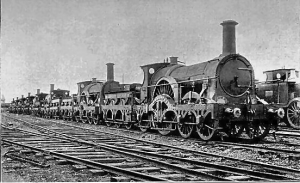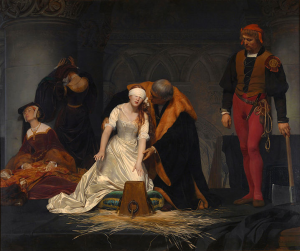As the year is drawing to an end, we thought we would compile a selection of the most interesting articles and books we have come across over the course of 2016. Some of them are amusing, some of them are touching, and some of them are downright disturbing, but we think that they represent the wide range of material that we cover in the Bibliography.
(The articles have been ranked chronologically and do not represent any favouritism on the part of the editors)
1. Off to a flying start, we have ‘Human Flight in Early Medieval England: Reality, Reliability, and Mythmaking (or Science and Fiction)’ an article by James Paz in New Medieval Literatures about Eilmer of Malmesbury, an Anglo-Saxon Benedictine monk. Supposedly, inspired by the story of Icarus, he took to the skies with some homemade wings, launching himself from the top of Malmesbury Abbey. Incredibly, he lived to tell the tale, and after gliding for a full furlong, landed almost intact, merely suffering two broken legs. The article examines the mythology surrounding the story, examining early medieval technology and questions whether there may be some truth in the tale.
2. Perhaps Eilmer would have benefited from the subject of our next article, ‘Evidence for the Continued Use of Medieval Medical Prescriptions in the Sixteenth Century: A Fifteenth-Century Remedy Book and its Later Owner’ in the journal Medical History. Margaret Connelly has studied a manuscript from the fifteenth century containing 314 medical remedies (Oxford, Bodleian Library, Rawlinson c. 299) and has charted its progress into the sixteenth century, where it continued to be used and added to by a London lawyer who owned it. The article provides an interesting insight into medieval ailments, and also how manuscripts continued as useful, everyday objects in the era of print.
3. Unfortunately, there is no known cure for our next subject, ‘We Should Dress us Fairly for our End’: The Significance of the Clothing Worn at Elite Executions in England in the Long Sixteenth Century’ a sobering article in History by Maria Haywood. The article discusses a neglected part of the process of trial and execution, and examines the possible statements aristocratic prisoners may have been making through their sartorial choices.
4. At number four, we have a collective volume, ‘The Senses in Early Modern England : 1558-1660’, edited by Simon Smith, Jackie Watson and Amy Kenny. The essays cover a wide range of genres such as literature, drama and art, considering each of the five senses and examining how the sensory experience enhanced reactions to cultural life. Chapter headings such as ‘Thou art like a punie-Barber (new come to the trade) thou pick’st our eares too deepe’: barbery, ear-wax and snip-snaps’ throw an interesting light on early modern art and life.
5. Continuing the seasonal cheer (!), Steven Taylor’s article ‘Depraved, Deprived, Dangerous and Deviant: Depicting the Insane Child in England’s County Asylums, 1845–1907’, also from History, explores the developing ideas of childhood during the nineteenth century and how they related to mentally impaired children. The attitudes towards these children, both from the medical institutions and family members are discussed, and the possible motives that both sides may have had in institutionalizing minors.

Image from Wikipedia
6. Our sixth article ‘Shattered Minds: Madmen on the Railways, 1860–80’ also taps into the Victorian fascination with lunacy. In the Journal of Victorian Culture, Amy Milne-Smith describes the moral panic that ensued from a number of newspaper reports that travelling on the newly constructed railways could induce insanity among men. Although fear of train crashes may have been a reasonable anxiety, there was also a concern that perfectly sane men could go mad when faced with modern, industrialized culture. Milne-Smith discusses the attitudes towards the fragility of the mental health of the Victorian male in this fascinating article.
7. A festive theme for number seven, titled ‘The Christmas Truce : Myth, Memory, and the First World War’ is a book by Terri Blom Crocker, analysing the truces between German and Allied troops in the trenches in the First World War. Rather than being unofficial and defiant affairs, Crocker provides evidence that the ceasefires were supported by senior officers, and charts how the 1914 truces have been mythologised as heart-warming tales with little regard for the actual truth.
8. ‘Antipathy to Ambivalence: Politics and Women Police in Sussex, 1915–45’ by Derek Oakensen is our choice for number eight, featured in Sussex Archaelogical Collection. The article focusses on women’s changing role in society after the suffrage movement and the upheaval of the First World War, and whether this created greater opportunities in Sussex for women wanting to join the police force. Women patrolling the streets was a serious change to the status quo, and Oakensen argues that due to the ambivalence and disjointed structure of the senior police force, women’s roles within the police force were not clearly defined until after 1945.

Mirror bee orchid. Image from Wikipedia
9. Departing from authority and moving onto a botanical theme, at number nine is ‘Deceived by Orchids: Sex, Science, Fiction and Darwin’ by Jim Endersby. Published in The British Journal for the History of Science, this interesting article discusses pseudocopulation (the biological trick plants play on male insects, pretending to be female insects to entice the male to mate, thereby enabling the spread of pollen from flower to flower), a phenomenon that earlier natural scientists such as Darwin had failed to spot, assuming that plants were passive. However, as part of to the infiltration of science into mainstream culture, writers such as Grant Allen and H.G.Wells portrayed plants in a new way, as having identities equipped with the means to pursue their own survival. It was these literary innovations in the depiction of plants which enabled early twentieth century scientists to make the conceptual leap to understand plants as active agents, and helped them further unlock their biological secrets.
10. And finally, at number ten, we have ‘Went into raptures’: reading emotion in the ordinary wartime diary, 1941–1946’ in Women’s History Review. Alison Twells highlights the importance of social class when looking at emotion, an often understudied category. Analyzing the diary of a working-class girl in the Second World War, the emotional and romantic life of an ‘ordinary’ person gives an insight into the daily trials and tribulations of a woman in the twentieth century.
There were many articles that didn’t quite make the top ten, but equally as interesting, such as:
Masters of Healing: Cocaine and the Ideal of the Victorian Medical Man
Thumb Wars: Hitchhiking, Canadian Youth Rituals and Risk in the Twentieth Century
When the smoke cleared: Tobacco supply and consumption by the British Expeditionary Force, 1914-1918
Changing Conceptions of the “Poor Child”: The Children’s Country Holiday Fund, 1918–1939
‘Inequality’ and ‘value’ reconsidered? the employment of post office women, 1910–1922
From the Bibliography of British and Irish History, we wish all of our researchers a peaceful Christmas and a happy new year


